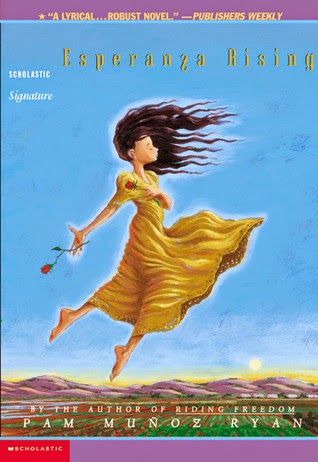I seem to have hit a streak of less-than-impressive
books, so there’s only one this month.
As always, the cover and summary come from
Goodreads; the review is mine.
Esperanza Rising – Pam Muñoz Ryan
Esperanza thought she'd always live with her family on their ranch in Mexico—she'd always have fancy dresses, a beautiful home, and servants. But a sudden tragedy forces Esperanza and Mama to flee to California during the Great Depression, and to settle in a camp for Mexican farm workers. Esperanza isn't ready for the hard labor, financial struggles, or lack of acceptance she now faces. When their new life is threatened, Esperanza must find a way to rise above her difficult circumstances—Mama's life, and her own, depend on it.
Review:
This middle-grade novel is based on the life of the
author's grandmother. Thirteen-year-old Esperanza is a rich girl living in
Mexico when her father is murdered. She is forced to flee to California with
her mother and work as a farm laborer to support herself and her mother.
This book is set during the Great Depression, but the themes are still relevant today. It confronts the issues of racism, classism, discrimination, immigration, labor strikes, and economic problems. It shows the importance of family and of being kind to people who are different from you.
The characters are well-developed, and the setting is very vivid. Nothing in the book is oversimplified or "dumbed down" for children. I like the Spanish words that are used in dialogue and as the chapter titles. If you don't know Spanish, all of them are translated for you. There are a lot of historical details, but I would have liked the book even more if it had included more historical details.
I did have a hard time getting interested in the story. I didn't think that Esperanza and her family were very relatable in the beginning of the book. The characters become more relatable as the story progresses.
This is a quick read for adults and an educational read for children. It would be great as part of a social studies curriculum. There is a lot of material in it for parents and teachers to talk about with their students.
This book is set during the Great Depression, but the themes are still relevant today. It confronts the issues of racism, classism, discrimination, immigration, labor strikes, and economic problems. It shows the importance of family and of being kind to people who are different from you.
The characters are well-developed, and the setting is very vivid. Nothing in the book is oversimplified or "dumbed down" for children. I like the Spanish words that are used in dialogue and as the chapter titles. If you don't know Spanish, all of them are translated for you. There are a lot of historical details, but I would have liked the book even more if it had included more historical details.
I did have a hard time getting interested in the story. I didn't think that Esperanza and her family were very relatable in the beginning of the book. The characters become more relatable as the story progresses.
This is a quick read for adults and an educational read for children. It would be great as part of a social studies curriculum. There is a lot of material in it for parents and teachers to talk about with their students.
~*~
All The Things = 16
Books
I’m Currently Reading: Burned by Ellen Hopkins




